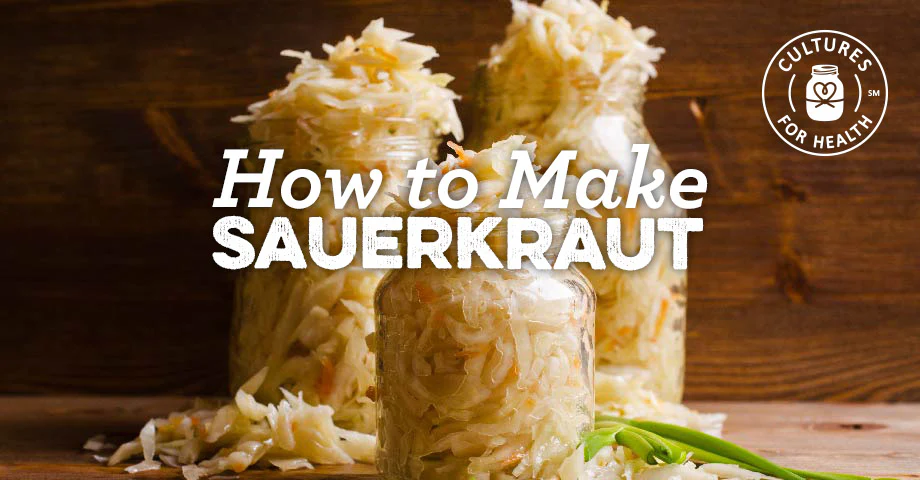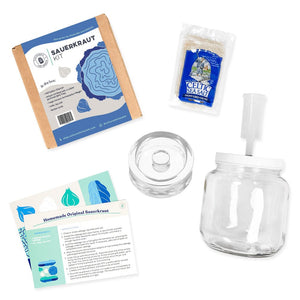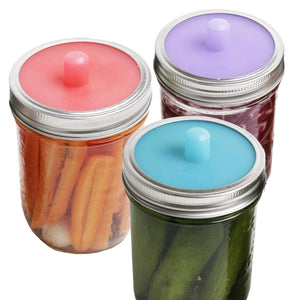
Homemade Sauerkraut is probably the most well-known lacto-fermented vegetable. Old fashioned sauerkraut is made with thinly sliced cabbage and salt. Like any traditionally homemade food, sauerkraut can be made in a number of ways with all kinds of custom variations. Check out our Garlicky Kraut, Dill Pickle Sauerkraut, and Southwestern Kraut when you're ready to get adventurous! Whether you add a secret ingredient to your homemade sauerkraut or keep it basic, kraut has a slew of health benefits. It is rich in probiotics, vitamins, fiber, and minerals, which can contribute to better digestion and a stronger immune system. Sauerkraut can also help promote a healthy heart, stronger bones, and weight loss.
While there are as many methods and tweaks to homemade sauerkraut recipes as there are home cooks, we do have a few tips that we've found in our sauerkraut testing.
30 minutes
336 hours
1 Quart
INGREDIENTS AND EQUIPMENT AVAILABLE AT CULTURES FOR HEALTH
Sauerkraut Making Kits

Sauerkraut Making Kits
$35.99
Make delicious, tangy sauerkraut at home with our DIY Sauerkraut Kit!
This kit is also great for making kimchi, pickles, and other fermented vegetables! Equipment in the kit may appear different than pictured.
Celtic Sea Salt Light Grey (Course) 1/4 lb
Pickle Packer - Vegetable Tamper & Muddler

Pickle Packer Vegetable Tamper
$19.95
Pack in vegetables for small-batch fermentation with this Pickle Packer.
Pickle Pipe for Wide Mouth Jar - Fermentation Airlock (4 Pack)

Pickle Pipe for Wide Mouth Jar - Fermentation Airlock (4 Pack)
$23.95
Use this one-piece, self-sealing, silicone and water-less airlock with wide mouth mason jars to enjoy ferments without the need to burp your jars!
These fermentation toppers are 3.3 inches in diameter and precisely fit wide mouth mason jars.

Learning how to make sauerkraut at home is a skill that has been passed down through generations. And with a few easy steps, you can make delicious homemade sauerkraut right in your own kitchen.
Like any traditionally homemade food, sauerkraut can be made in several ways with all kinds of custom variations. Check out our Garlicky Kraut, Dill Pickle Sauerkraut, and Southwestern Kraut when you're ready to get adventurous!
Whether you add a secret ingredient to your homemade sauerkraut or keep it basic, kraut has a slew of health benefits. It is rich in probiotics, vitamins, fiber, and minerals, which can contribute to better digestion and a stronger immune system. Sauerkraut can also help promote a healthy heart, stronger bones, and weight loss.
If you’re a beginner at fermenting, don't worry, our comprehensive guide on how to make sauerkraut will take you through the process step-by-step. We also offer tips and troubleshooting advice to ensure your first batch of sauerkraut is a success.
You want to know more on what to eat with sauerkraut?
NECESSARY SUPPLIES FOR MAKING HOMEMADE SAUERKRAUT
When it comes to fermentation supplies, there are a lot of tools out there to choose from, and honestly, most of them will work just fine. This can be a bit overwhelming if you're new to making fermented foods and just trying to figure out what you need to get started. To make it a little easier, we've created a simple Sauerkraut Kit with everything you need to get started.
But if you want to build your own kit, our tutorial “Fermentation Equipment: Choosing the Right Supplies” goes into detail about different options. Honestly, you don't need much to get started. A few basics like a good knife, acontainer for fermenting, a fermentation weight, and some sort oflid with an airlock will do.
OUR FAVORITE HOMEMADE SAUERKRAUT RECIPE
Below you'll find our basic sauerkraut recipe. This recipe utilizes the pounding and kneading methods. It is a great place to start for anyone just beginning to explore fermented vegetables.
Once you've mastered the basics, you can vary this recipe by adding other vegetables, herbs, and spices. Or use one of our other sauerkraut recipes for inspiration.
INGREDIENTS FOR HOMEMADE SAUERKRAUT:
- 1 Medium Head of Cabbage
-
1-3 Tbsp. sea salt
HOW TO MAKE SAUERKRAUT: STEP-BY-STEP INSTRUCTIONS:
-
Chop or shred the cabbage into strips or chunks suitable for eating. Most people prefer thin slices, but rustic sauerkraut is also nice. Sprinkle the sliced cabbage with salt.

-
Knead the cabbage with clean hands, or pound with a potato masher or Cabbage Crusher for about 10 minutes. As you do this, the cabbage will start to release liquid. Continue until there is enough liquid to cover the cabbage when it’s packed into jars.
-
Stuff the cabbage into a quart jar, pressing the cabbage underneath the liquid. If necessary, add a bit of water to cover the cabbage completely.
-
Weigh down the cabbage and Cover the jar with an airlock lid of some sort. While purpose-made airlock lids are the easiest option, using a regular jar lid is also possible. But then you have to remember to burp the sauerkraut daily so that the pressure doesn't build up.
-
Culture at room temperature (60-70°F is preferred) for at least 2 weeks until desired flavor and texture are achieved. If using a tight lid, burp daily to release excess pressure.
-
Once the sauerkraut is finished, put a tight lid on the jar and move it to cold storage . The sauerkraut's flavor will continue to develop as it ages.
SAUERKRAUT RECIPE VARIATIONS:
There are many variations of sauerkraut recipes, and it is easy to tailor the flavor to your family's taste. The following are some suggestions on how you can change the recipe to make your own perfect batch:
- For a more complex flavor, add caraway seeds (to taste).
- Prior to culturing, you can also mix 1 part of other vegetables or ingredients (shredded carrots, apples, etc.) with 5 parts cabbage to vary the recipe. For non-traditional sauerkraut, try this carrot sauerkraut recipe or a zucchini kraut recipe.
- Or try one of these cabbage sauerkraut recipes:
EASY TIPS FOR HOW TO MAKE SAUERKRAUT
While there are as many methods and tweaks to homemade sauerkraut recipes as there are home cooks, we have a few tips that we've found in our sauerkraut testing.
USE FRESH CABBAGE:
For great sauerkraut, begin with fresh ingredients. The better the ingredients, the better the final product. Pulling fresh cabbages from your garden or finding those last few just-in-season heads at your local farmer's market will yield some of the best results. But sauerkraut is also forgiving, so even a midwinter cabbage from the grocery store has yielded us some great results.
USE THE RIGHT SALT:
Salt is a traditional ingredient in sauerkraut because it increases shelf life, texture, and flavor. Plus, it also inhibits the growth of unfriendly bacteria, fungi, and molds. The amount of salt used can vary according to personal taste preference, but we recommend 1 to 3 Tbsp. Per quart of water.
When making sauerkraut, it’s also important to choose the right salt. Normal table salt contains iodine and anti-caking agents that can inhibit the growth of the beneficial bacteria we're looking for. We've achieved the best results with unrefined sea salt.
The Celtic Sea Salt we sell at CFH is hand-harvested using traditional methods on the French coast. It's completely unrefined and dried from the ocean, resulting in a variety of minerals and a fantastic bit of extra flavor that you just can't get any other way. It has all we need for fermentation! That's why Celtic Sea Salt has become our salt of choice. For those that don’t want to use salt, check out our salt-free sauerkraut recipe.
CREATE AN ANAEROBIC ENVIRONMENT FOR YOUR SAUERKRAUT:
Any sauerkraut recipe is incomplete without this step. The cabbage must be completely submerged underneath a brine and away from oxygen for the lactic acid bacteria to proliferate. This is important for protecting your lactic acid fermentation from unwanted bacteria (or mold).
The main reason we see sauerkraut fermentations fail is because of the addition of oxygen to the ferment, which can lead to the growth of undesirable bacteria as well as funguses and molds. These can render the entire batch inedible.
After extensive testing, we've come up with a couple of our favorite ways to keep your sauerkraut safe. While you can seal up the jars and burp them daily, these super simple "Pickle Pipe for Wide Mouth Jar" automatically vent the extra CO2 safely without allowing oxygen in. They also fit over regular small-mouth mason jars and wide-mouth canning jars. For larger ferments, we recommend the half-gallon vegetable fermenter, which is perfect for a big batch of sauerkraut.
You'll also want to use Fermentation weights to help keep your cabbage submerged under the brine, so it doesn't mold. We love these easy-cleaning glass fermentation weights for small-mouth mason jars and wide-mouth jars. For larger containers, we use these two-piece ceramic fermentation weights.
GIVE YOUR SAUERKRAUT TIME:
You can ferment sauerkraut for only a few days before moving it to cold storage. But giving sauerkraut a lower temperature and longer fermentation time can develop the flavor and texture a little better. We suggest letting it ferment for 2 weeks, though experimenting with time and taste is the best way to determine what time frame works best for you.
Need more tips? Take a look at how to ferment vegetables and when to place them in cold storage.
Click here to download our sauerkraut Lacto-fermentation recipe ebook, which is full of recipes and tips to take your sauerkraut experience to the next level.
DIFFERENT METHODS FOR MAKING SAUERKRAUT
There are various methods that can be used to make sauerkraut, depending on the equipment you have at hand. We'll let you in on some of our favorite ways to make this tasty side dish.
SLICING, POUNDING, AND KNEADING CABBAGE
Thinly slice cabbage, salt it, then pound it with a tool such as the Cabbage Crusher or Pickle Packer for about 10 minutes, or until enough juice is released to form a brine and completely cover the cabbage.
Move the cabbage and juice to fermentation containers, and weigh the cabbage down to keep it below the brine. Cover with tight-fitting lids, airlock lids, or a tight-weave cloth secured with a rubber band.
WEIGHTING AND PRESSING SAUERKRAUT IN A CROCK
Place shredded cabbage and salt in a large half-gallon vegetable fermenter or another fermenting container. Pack the cabbage tightly into the container and weigh the cabbage down with weights or pickle pebbles. Press on the weights to draw the natural juices out of the cabbage and submerge the cabbage slowly in the brine.
With continued pressing, the cabbage will have accumulated a fair amount of liquid at the top to cover the cabbage completely.
WHOLE CABBAGE HEADS WITH BRINE
In this method, the cabbage is not shredded or sliced before fermenting. Since whole cabbage heads cannot form their own brine fast enough to protect them from mold and unwanted yeasts, a brine is generally created and then used for fermenting.
While this method is the least labor-intensive, it takes the longest. Four weeks or more are necessary before moving to cold storage because of the size of the cabbage heads.
SAUERKRAUT RECIPE FAQs
WHICH CABBAGE IS BEST FOR SAUERKRAUT?
Sauerkraut can be made with any sort of cabbage. But we find it's best with leaves from crunchy, hard varieties. For instance, Bravo, Bronco, Danish Ballhead, Krautman, Late Flat Head, and Premium Late Dutch aregood varieties for sauerkraut.
DO YOU WASH CABBAGE BEFORE MAKING SAUERKRAUT?
You don't need to wash sauerkraut. The fermentation process is started by the naturally occurring bacteria found on cabbage. So rinsing it is not necessary, nor does it help. If you want to be extra safe, you can simply remove a few of the outer leaves, and you're good to go!
HOW DO YOU KNOW WHEN SAUERKRAUT IS DONE?
Fermentation isn't a process that is set in stone. The best way to tell if sauerkraut is done is to wait until you don't see any more bubbles in the brine. Or until you've tasted it and decided it's done. Generally, 2-5 weeks will get you a nice, tangy flavor.
CAN SAUERKRAUT FERMENT TOO LONG?
Cabbage can become mushy if left out for too long because of its high water content. Plus, the longer you leave it, the more tangy the taste will be. So, it’s best not to leave it for too long.
Want to start making your own homemade sauerkraut? Download our Lacto-Fermentation Guide and Recipe Book Today!
















